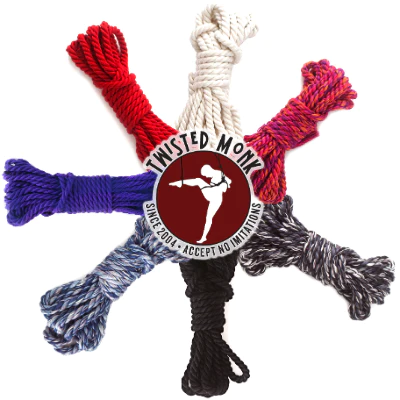Cinch with Gusto
Emotions lead to motion.
Motion leads to emotions.
Rhythm and expression color the narrative of a scene, while movement and gestures punctuate it.
The body moved confidently, inspires confidence.
A quick flick of the tying hand snaps the mind into the now. A sure-handed final cinch of a knot quickens the pulse.

The human mind lights up to changing rhythms and variations sensed. A constant steady beat might be soothing and meditative, like the droning of a fan. Still, it may become monotonous, leading to mental numbness, slipping attention, fading presence, or just plain boredom. Boredom is a creeping scene killer.
Tie timidly or tentatively, and your partner’s confidence in you may erode. For many receiving ropes, your timidity awakens their internal “play scene monitor.” This causes their mental resources and attention to be diverted to vigilance and self-protection. In this state, how can they fully participate to enjoy the scene, delight in you, and be in the ‘now’?
So, cinch with gusto, as I say so often in my classes.
Intention, mood, rhythm, expression, movement, and gestures; are all essential ingredients for creating delicious scenes. Cinching with gusto combines all these ingredients in one swift flambé burst.
Your body makes the rhythm and melody. Notice this the next time you play. When playing, tie and move from your core. Invest your body into the scene with awareness of the rhythm you and your partner create. Playtime has a narrative or story arc, even the short, sweet, and simple ones. This dramatic arc of your scene is framed by a mutually agreed-upon intention and scenario.

Think of the mood you and yours seek as the genre of the scene. What’s a ‘genre’ of a scene? It’s much like the genres of movies: action, romance, rom-com, horror, suspense, superheroes, esoteric Euro-trash emo, and whatever it is that Sacha Baron Cohen makes. Each cinematic genre has its pace, expected emotions, coloring, and camera movement. What movie genres would your scenes be?
Perhaps you might prefer music and its genres: classical, rock, punk, hip hop, R&B, jazz, country, waltz, EDM, reggae, and whatever that is that Weird Al Yankovic makes. Every musical genre has its emotions explored, chords, instruments, structure, and sounds. What music genres would your scenes be?
Intention is the “why” of the experience, and mood is the emotional tone. Whether or not we are aware of it, there is always an intention when using rope. We seek to feel something, though it’s all too common that we don’t notice or articulate our wants. Instead of giving words to our emotional hunger or the intentions we seek, we simply ask to tie or be tied, or name the shape of a tie – and hope to be understood at some deep level. This is a tall ask of anyone.
Even simple practice has the intention of acquiring a skill, building confidence, reducing anxiety, or simply having a pleasant social interaction with someone you like. The mood sought may be serious or light-hearted, focused or chill, challenging or encouraging, but there’s always some desired tone or mood.
Below you’ll find a couple of exercises to help you to Cinch with Gusto.
Exercise I. “Grok the Cinch” or the Tie Pacing Exercise
This is a partnered exercise. (Person A & Person B)
Solo people can do this as well. For solo practice, pay extra attention to your internal experience of this drill set.
You will be tying a two-column tie. Choose a style of two-column tie. To start with, try a two-column tie that you are familiar with. For a challenge, tie one you’re less experienced with.
Decide with your partner what parts of the body and which two columns on them you will tie. You can choose to repeat the steps on the same body parts or change them.

Throughout this exercise, for each step, each of you has an assignment about attention and focus.
- Person A: Don’t look at the tying. Close your eyes, or better still, look at your partner. Pay attention to your mind and emotional state. Imagine your mind-state and feelings as if this were a play scene.
- For an extra challenge, notice your partner’s response using all your senses. Don’t ask them. Try to feel and perceive it through the ropes and hands.
- Person B: For steps 1 through 3, don’t look at the tying. Close your eyes, look at your partner, or just look anywhere else. Pay attention to your mind and emotional state. Imagine your mental state and emotions as if this were a play scene.
Step 1
- Person A: Tie a two-column tie slowly on Person B without changing pace. Make sure that the rate of movement is the same from beginning to end.
Step 2
- Person A: Tie the same two-column tie much faster, but again, with that same pace throughout tying.
Step 3
- Person A: Tie the same two-column tie, this time with a consistently fast pace all the way through until you are nearly at the last two moves.
- Person A: Make the last two moves super slow.
Step 4
- Person A: Tie a two-column tie slowly until the last two moves.
- Person A: Make the last two tying and gestures fast. Make it a bit dramatic. Dramatic can be a bit sharper and sudden motion or a quick but larger motion.
Step 5
- Person A and Person B: Discuss each of your sensations, interpretations, and emotions.
- What sensations did each of you experience?
- How would you express or interpret these?
- What emotional states might it lead to?
- What impacts could these have on the scenes you have or might have?

Exercise II. “Resist & Release”
This is a solo exercise.
For this training exercise, you want a cord or string that is super elastic. It doesn’t need to be strong. That it is a very stretchy cord is relevant, so it can be a bit flimsy. You’re not tying it onto a person, so it’s not a problem if it breaks.
Examples
- Exercise elastic bands of the lightest resistance
- Elastic waistband-type cord
- Elastic shoelaces
Step 1. Sit or stand comfortably. Engage your best posture.
Hold the band loosely with both hands close to you, one end in each hand, about 3 inches (8 cm) apart. Using just your hands from the wrists, pull it apart until it’s quite taut, keeping it in place for two or three long breaths. Release slowly, keeping in control of its traction. Do not let it snap back. Repeat a few times.

Advanced addition: After doing Step 1 with the ropes in your hands, try it with the cord with just two fingers of each hand. It might be your thumb and forefinger, thumb and middle finger, etc.
Step 2. Repeat Step 1, but move from your elbows without moving your wrists. Notice the difference.

Step 3. Repeat Step 1, but move from your shoulders, not from the rest of the arms. Notice the difference.


Step 4. You will repeat Step 3, (moving from the shoulders), but you won’t move your left hand this time. It might help to place your left hand against a wall and keep it there. Imagine it’s glued to the wall. You will pull the band with your right side only.
Movements to try: experiment with different combinations.
- Expand your chest
- Reach out your right arm
- Roll your right shoulder back
- Turn from your hip so you are rotating your whole torso
- Step out with the right leg as you reach your right hand out
Repeat with your right hand held still.

Step 5. Now repeat step 3, using both arms and moving from the shoulders. Notice the difference.
Step 6. Include these movements in your next play scene or practice time.
What’s the point of this weird exercise?
I have many hopes of benefit for you with this drill. Here are some of my intentions. You have probably figured out more benefits.
- Through this exercise, you can become more aware of your physical strength for moving, holding, and cinching with rope.
- You will notice where to move from to deliver different levels of strength, finesse, and impact.
- Learn different ways to move that might keep repetitive stress issues at bay.
- Practice engaging different parts of the self while tying, even the whole body.
- Increase body awareness and state of presence for the person tying.
- Turn your breathing and pacing in rope handling into a habit.
- Consider how the body and muscles work or don’t work while topping.
- …what did you discover?



-- -- -- --
Midori’s Bio
Trailblazing educator, sexologist, artist, and irritant to banality, Midori founded Rope Dojo and ForteFemme: Women’s Dominance Intensive. She penned the first English instruction book on Shibari titled “Seductive Art of Japanese Bondage” in 2001, paving the way for the popularity of rope. Dan Savage calls her the “Super Nova of Kink,” while others affectionately call her Auntie Midori for her cool, tell-it-like-it-is, funny, reality-based teaching. She is also the author of “Wild Side Sex,” “Master Han’s Daughter,” and “Silk Threads.”
During this pandemic, learn, laugh, and enjoy her special online classes, events, and art at www.patreon.com/PlanetMidori
Instagram: https://www.instagram.com/planetmidori/
Facebook: https://www.facebook.com/MidoriReallyMidori
Creative Living Coaching and Private Sexological Consultations: ask@planetmidori.com
----
Art by Nadia Vanilla www.nadiavanilla.com
Nadia Vanilla is an award-winning Phoenix-based erotic artist. She paints people of all walks of life, doing all sorts of fun things with their bodies. She aims to celebrate the human experience, in all its messy, colorful beauty.
She uses a variety of media to achieve this – lately, that includes digital painting and drawing, soft pastels, acrylic paints, watercolors, and ink.
----
Edited by Rose DeYott
Also in News

Exotic Bamboo Rope Review by Pete Riggs of Ropeconnections.com
Pete Riggs of Ropeconnections.com recently did a very through and in depth review of our exotic bamboo ropes, including washing! Check it out, along with tons of other great rope content and tutorials!


